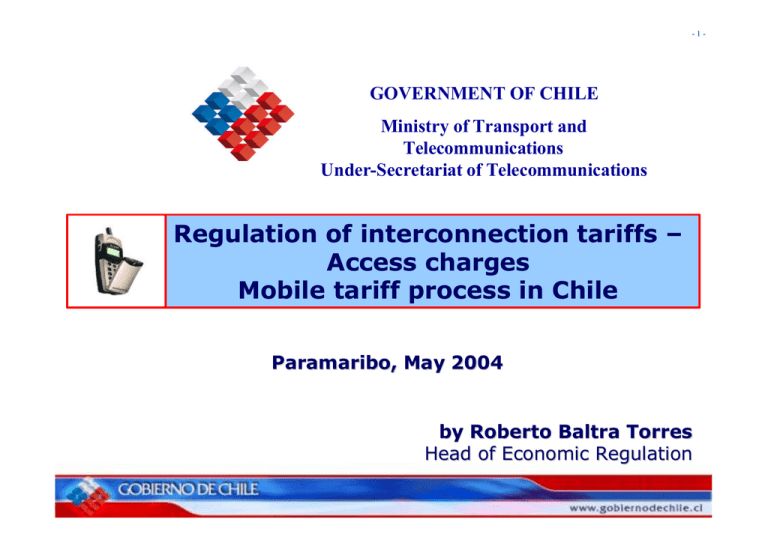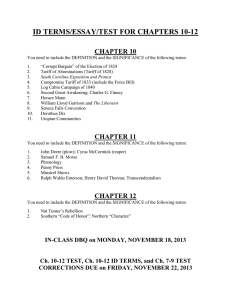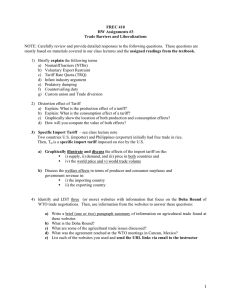GOVERNMENT OF CHILE Ministry of Transport and Telecommunications Under-Secretariat of Telecommunications
advertisement

-1-
GOVERNMENT OF CHILE
Ministry of Transport and
Telecommunications
Under-Secretariat of Telecommunications
Regulation of interconnection tariffs –
Access charges
Mobile tariff process in Chile
Paramaribo, May 2004
by Roberto Baltra Torres
Head of Economic Regulation
Tariff regulation: Normative aspects
•
•
Tariff freedom (general rule)
Obligatory services under law (Articles 24bis and
25)
– Services provided by public and intermediary
service licensees via interconnections.
Metering, billing, charging and collection
services supplied to carriers by public service
licensees (Supreme Decree No. 95 of 1994)
– Tariffs for the services provided via
interconnections enable licensees to cover the
cost of use of their networks.
-2-
Tariff regulation: Normative aspects
•
Principal services regulated in the context of
public mobile telephony service licensees are:
– Interconnection at network termination points
– Access to other telecommunication service
licensees
– Administrative functions (metering, charging,
billing, collection, account management).
-3-
Tariff regulation: Content
•
Fundamental principles of tariff-setting:
– Tariffs charged to users reflect costs.
– Guarantees the absence of cross-subsidization between
services and tariff areas.
– Use of the efficient enterprise model generates
incentives so that the real licensee introduces
technological improvements in its network and regulated
services, thereby increasing their efficiency.
– The tariff-setting process enables any efficiency gains
achieved by the company as a result of improved
management and technological development to be
passed on to the consumer.
-4-
Tariff regulation: Content
•
Efficient enterprise (Act 18.168 Articles 30A
and 30F):
– Provides only regulated services
– Only essential service provision costs
– Using available technology
– Maintaining quality
– Determining costs of each service: investment
and operation including capital costs
– Invisibility and non-regulated services: only a
portion of the costs is used, in accordance with
the proportion of the assets used.
-5-
Tariff regulation: Content
•
Incremental development cost (IDC)
(Article 30)
– General rule: marginal cost pricing
– Expansion plans for each service by tariff area
– The IDC is obtained for each expansion plan
– Exception: long-run marginal cost
– In the absence of expansion plans
•
Long-run total cost (LTYC) (Article 30C)
– Project for replenishment of the efficient
company’s assets
– Mean volume of provision of the various services.
-6-
Tariff regulation: Content
•
Efficient tariffs (Article 30E)
– Generate revenue equivalent to IDC (marginal cost).
– In case of more than one regulated service in a tariff
area, equal marginal profits.
– If expansion project provides non-regulated services:
only part of IDC is used, in line with proportion of assets
used.
•
Final tariffs (Article 30F)
– If, and only if, there are economies of scale.
– Efficient tariffs are increased until the long-run total cost
(LRTC) is reached.
– Minimize introduction of inefficiencies.
– If efficient company provides non-regulated services:
only part of LRTC is used, in line with proportion of
assets used.
-7-
Tariff regulation: Content
•
Rate of capital cost (Article 30B)
–
–
–
–
•
Risk-free rate of return
Systematic risk of company
Risk premium
Rate of capital cost = risk-free rate + systematic risk *
risk premium
Indexation
§
§
§
An index is determined for each service
Based on published input price indices
Representative of cost structure of efficient company.
-8-
Procedure: Techno-economic bases (TEBs)
Notification
Notification
registration
registration
participants
participants
Licensee
Drawing
Drawingup
upof
of
techno-economic
techno-economic
bases
bases
(TEBs)
(TEBs)
Draft TEBs
Registered
Registered
third
third
parties
parties
Opinions
Proposal for
TEBs
Subtel
Revision
Revisionand
and
elaboration
elaboration of
of
preliminary
preliminaryTEBs
TEBs
Referral of
preliminary TEBs
Licensee
Revision
Revisionand
and
elaboration
elaboration of
of
disputed
disputedissues
issues
-9-
Procedure: Techno-economic bases (TEBs)
Licensee
Revision
Revisionand
and
elaboration
elaboration of
of
disputed
disputedissues
issues
If necessary refers
disputed issues to
Committee of Experts (CoE)
Subtel
Analysis
Analysisand
and
resolution
resolutionof
offinal
final
TEBs
TEBs
Notifies final
TEBs
Licensee
Initiates
Initiatestariff
tariff
study
study
Dossier
Committee
Committee
of
ofExperts
Experts
(CoE)
(CoE)
Opinion
- 10 -
Procedure: Tariff- setting
- 11 -
Licensee
Elaboration
Elaborationof
of
tariff
tariffstudy
study
Tariff
proposal
Opinions
Registered
Registered
third
third
parties
parties
Ministries
Revision
Revisionof
of
tariff
tariffstudy
study
Dossier
Report on objections
and counter-proposals
Licensee
Incorporates
Incorporates
or
orresubmits
resubmits
Resubmission
report
Ministries
Final
Final
decision
decision
Opinion
Committee
Committee
of
of
Experts
Experts
Procedure: Tariff- setting
Ministries
Final
Final
decision
decision
Endorsment
report
Ministries
Elaboration
Elaborationand
and
signature
tariff
decree
signature tariff decree
Tariff
decree
Possible
objections
Office of the Controller General of
the Republic
Review
Review
Processing of
tariff decree
Official
journal
Publication
Publicationof
oftariff
tariff
decree
decree
Dossier
Ministries
Clarifications
Clarifications
relating
relatingto
totariff
tariff
process
process
Consultations
- 12 -
- 13 -
Procedure: Tariff process
CoE
Submission of
Formation report
disputed issues
and
and recourse to
Committee of swearing-in
Draft
of CoE
TEBs Experts (CoE)
Presentation
of TEB
proposal
Notification
of start of
process
-380
-360
-365
(20)
20
10
Registration
of participants
-340
-355
0
(Subtel requires
TEB proposal
for new
licensees)
5
-290
5
10
15
20
CoE
Notification
clarification of start of
report
tariff study
5
25
10
30
3
-270
5
70
30 40
Presentation of
tariff study
-180
2
90
80
180
Comments from
participants
Subtel calls on
CoE
Preliminary
Request for
clarifications
Final TEBs
TEBs
-180
-60
-30
0
-180
120
30
210
Opinions on
tariff study
Presentation of
tariff study
5
30
300
Formation of
CoE
Report on objections
and counterproposals
30
330
Report containing
amendments and
resubmissions
CoE
report
360
Endorsment
report and tariff
decree
- 14 -
Chilean market: Previous situation
- 15 -
Chilean market: Mobile subscribers
Evolución
Telefonía
Móvil: Abonados
Móviles y Penetración
Trends
in mobile
telephony:
mobile subscribers
and penetration
(1990
(1990- –
Marzo
March
2003)
2003)
8.000.000
41,1
42,6
47,0
42,0
7.000.000
37,0
34,0
6.000.000
Mobile
Telefonía Móvil
telephony
5.000.000
32,0
Penetración
Penetration
27,0
22,2
4.000.000
22,0
15,0
17,0
3.000.000
12,0
2.000.000
1.000.000
6,5
0,1
0,3
0,5
0,6
0,8
1,4
2,2
7,0
2,8
2,0
-
-3,0
1990
1991
1992
1993
1994
1995
1996
1997
1998
1999
2000
2001
2002
Mar-03
Mobile subscribers: Prepayment vs.
contract
Trends in numbers of mobile subscribers
Evolución
de Abonados
Móviles según
according
to commercial
plan
Plan Comercial
(January
1999 – June 2002)
(Enero 1999 - Junio 2002)
5.000.000
4.500.000
4.000.000
3.500.000
3.000.000
2.500.000
2.000.000
1.500.000
1.000.000
Apr 02
Abr-02
Oct 01
Oct-01
Jul 01
Jul-01
Apr 01
Abr-01
Prepago
Prepayment
Jan 02
Ene-02
Contrato
Contract
Jan 01
Ene-01
Oct 00
Oct-00
Jul 00
Jul-00
Apr 00
Abr-00
Jan 00
Ene-00
Oct 99
Oct-99
Jul 99
Jul-99
Apr
Apr99
99
Abr-99
Jan 99
Ene-99
500.000
0
- 16 -
Lines in service vs. mobile subscribers
Lines
in en
service
vs.
mobile
subscribers
Lineas
Servicio vs
Abonados
Móviles
(January
(Enero 20002000
- Junio
– 2002)
June 2002
6.000.000
Líneas
Lines inen
service
Servicio
5.000.000
Mobile subscribers
Abonados
Móviles
4.000.000
3.000.000
2.000.000
1.000.000
Jan
00
Ene-00
Apr
00
Abr-00
JulJul-00
00
OctOct-00
00
Ene-01
Jan
01
AprAbr-01
01
Jul Jul-01
01
OctOct-01
01
Ene-02
Jan
02
Apr
Abr-02
02
- 17 -
Monthly traffic per mobile subscriber
Average
traffic
(generated)
subscriber
Tráficomonthly
Promedio
Mensual
(generado)per
pormobile
Abonado
Móvil 1/ 1/
(Minutos
(actual Efectivos)
minutes)
Type de
of traffic
Firstquarter
wuarter
2003
(p)Primer
First
quarter
First
2003
(p)
First
quarter2002
2002
Tipo
Tráfico
Primer Trimestre
2003
(p)
Trimestre
2002
Móvil
- Móvil
43,0
44,8
Mobilemobile
43.0
44.8
Móvil
- Fijo
17,3
19,8
Mobilefixed(S)
17.3
19.8
MobileLDI
LDISalida
outgoing
0.2
0.20,2
Móvil
0,2
Mobile Internet
0.0
0.0
Móvil
Internet
0,0
0,0
Mobile supplementary
Móvil
SSCC
Salida
1,3
services
outgoing
1.3
1.61,6
Total
62
6666
Total
62
Variation
(%)(%)
Variation
(%)
Variación
-4,1%
–4.1%
-12,3%
–12.3%
–9.0%
-9,0%
–
—
-19,1%
–19.1%
–6.8%
-6,8%
SUBTEL,
sobre
la baseon
de información
proporcionada
lasmobile
compañías
móviles y portadores.
SUBTEL,
based
information
suppliedporby
operators
and carriers.
(p)P)
Cifras
preliminares.
Preliminary figures
áfico
promediotraffic
por abonado
mes se elaboró
el promedio
de la relación as
de tráfico/número
de of
abonados
mensual,
Average
per al
subscriber
percomo
month
was calculated
the average
the ratio
of lo
estraffic
equivalente
a
la
división
entre
el
tráfico
anual
y
el
número
de
abonados
a
fines
de
cada
año.
subscriber numbers per month equivalent to the division between annual traffic and
the number of subscribers at the end of the year.
- 18 -
- 19 -
Composition of traffic carried
ComposiciónComposition
del Tráfico cursado
a través
de laonRedes
de networks
Telefonía Móvil
of traffic
carried
mobile
(Primer Trimestre 2003)
(First quarter 2003)
Mobile CCSS
(incoming + outgoing) Remainder
1.3%
1.9%
Fixed-mobile
24.4%
Mobile-mobile
51.5%
Mobile-Fixed (outgoing)
20.8%
Access charges: Previous situation
Cargo de Acceso, no incluye IVA
Access
charges
(excluding VAT)
(vigentes a Octubre de 2003)
(as at October 2003)
200,0
Standard
charging
Horario
Normal
period
Horario
Reducido
Reduced-rate
charging
period
(USD/minute)
($/minuto)
160,0
120,9
120,9
120,9
120,9
120,9
120,0
84,6
84,6
84,6
84,6
84,6
Bellsouth
Entel PCS
Móvil PCS
Smartcom
80,0
40,0
0,0
Telefónica Móvil
- 20 -
- 21 -
Tariff model
- 22 -
Overview
Geographical
coverage
Projection of
demand
Network
design
Technical
service
costs
(service
routing
factors)
Administrative
costs
Economic
cost
Cost of
regulated
services
Access
charges
- 23 -
Projection of demand: S- curves
12.000
Subscribers
(thousands)
Miles de Abonados
10.000
8.000
Actual
Real
Projected
Proyectado
6.000
4.000
2.000
0
1985
1990
1995
2000
Años
Years
2005
2010
Geographic segmentation of demand
Current
position
Current
position
Current
position
Network
design
- 24 -
Technical costs: Routing factors
Economic cost
per component
Service
routing
factors
NPV=0
Cost of
regulated
services
Access
charges
3-sector macro
BSC
NTP interconnecion
MSC/VLR
etc.
1
1
2
2
1
0
50
70
etc.
Assets
Mobile -> Mobile
Own network
Other operators
-> mobile
Services
- 25 -
Network design: Main considerations
•
•
•
•
•
•
Design “inputs”: area, traffic, number of
subscribers
Only voice services (not data). Monthly traffic
is calculated and peak-time traffic is projected
The real network is not designed; on the basis
of performance parameters, the requirements
for each item of equipment are calculated
GSM and possibly CDMA is used
Use of “routing factors”
Design for each year of forecast period
- 26 -
Network design: Coverage and capacity
Macrocell
site
HLR
BTS
Transmission
BTS - BSC
BSC
Transmission
BSC-MSC
MSC
Transmission
MSC - Others
Given: spectrum,
HC traffic,
bandwidths, reuse: No. of
sectors
Microcell
Design
parameters
Demand
Coverage
Coverage
network
Traffic
network
Total
network
- 27 -
Given:
quality of
service
Network design: Area and cell types
Four types of area
Metropolitan
Rural
Four types of BTS
Macrocell
Omni
Microcell
Urban
2-sector
macrocells
Highway
3-sector macrocells
- 28 -
Network design: Coverage requirements
100%
90%
80%
60%
50%
40%
30%
20%
10%
0%
10%
20%
30%
40%
50%
60%
70%
Area
Urban
0%
Metropolitan
Population
70%
Rural and highways
80%
90%
100%
- 29 -
Network design: Coverage equipment
•
Many network design calculations
are based on the following equation:
•
•
Number of components required = Demand/
(Capacity per component * use)
Use is a parameter for reflecting the
combination of various effects of
decreasing use:
•
Maximum design use: this usage parameter
ensures that network equipment is not
overloaded by any change in demand, e.g.
some types of equipment are recommended
to be used at no more than 90% of their
capacity.
- 30 -
Network design: Coverage equipment
•
Use is a parameter for reflecting the
combination of various effects of
decreasing use (continued):
– Use as a function of reasonable growth: in a real
mobile network, development of the network is in
response to expected demand (months to years),
depending on the modularity of the equipment and the
time taken to make all preparations for getting the new
equipment online.
•
Takes account of non-homogeneous
features of traffic.
- 31 -
Network design: Network component growth
Current use:
• Current use = Normal use * (xt/xt+p)
Demand
•
xt+p
xt
t
•
t+p
Time
Normal use = Design use *
Scorched node use * growth
- 32 -
Network design: Optimization model
Optimization
model
Number of BTS
Number of BSC
per primary zone
MSC number
and location
- 33 -
Network design: Switch location model
•
General layout
Input information
Model
Output
Optimum design
Demand projection
- Switches:
Switching costs
Switch location model
- Quantity
- Capacity
Link costs
- Link capacity
- 34 -
Network design: Switch location model
BTS
BSC
MSC
Min {Costs (Inv+Op)}
s.a.
- Meeting of demand
- Conservation of flow
- Capacities
- Switches
- Links
- 35 -
- 36 -
Tariff calculation: Economic cost
Database
Costs December
2002
Cost trends
over time
Useful
lifetime
Network
design
Demand
projection
Cost of
network
components
CAPEX
OPEX
Operacional
staff costs
Administrative
costs
Economic
cost by
component
NPV=0
Demand equilibrium: General description
This is a tool for stimulating the impact of a
change in access charges on the various tariffs
To do this, it finds out the new financial
equilibrium of the enterprise
- 37 -
- 38 -
Demand equilibrium: Values used
Elasticities
SUBTEL
Recommended
value
Equipment price
Unit
ηA
Mobile-fixed price
η mf
-0.49
Mobile-mobile (own network) price
ηmmp
-0.49
Mobile-mobile (other operators) price
ηmmo
-0.49
Fixed-to-mobile price
ηfm
-0.40
Crossed APP
ηAP
-0.03
-0.56
Demand equilibrium: Functional description
Change in access charge
Change in revenue
Recover revenue to maintain
financial equilibrium
Via traffic
Via equipment
subsidies
Change in demand
Via new tariffs
- 39 -
Demand equilibrium: Detailed description
• Delta revenue
∆IN = ( CA0 − CA1 ) ⋅ F0oo −m
• Recovery by flows
∆R1 = CA1 ⋅ ( F1oo −m − F0oo −m )
• Recovery by subsidies
(
)
(
)
∆R 2 = C A − S1A ⋅ D1A − C A − S 0A ⋅ D0A
• Recovery by prices
∆R 3 = ( P1mf − C tf ) ⋅ F1mf − ( P0mf − C tf ) ⋅ F0mf
+ P1mmo ⋅ F1mmo − P0mmo ⋅ F0mmo
+ P1mmp ⋅ F1mmp − P0mmp ⋅ F0mmp
- 40 -
Demand equilibrium: Detailed description
• Flows
F1
mf
=F
mf
0
P1m f − P0mf
⋅ 1 +
mf
P
0
P −P
F1mmo = F0mmo ⋅ 1 +
P
mmo
0
mmo
1
mmo
0
P −P
F1mmp = F0mmp ⋅ 1 +
mmp
P
0
mmp
0
mmp
1
η mf
η mmo
η mmp
- 41 -
Demand equilibrium: Detailed description
- 42 -
• Subscribers
ηA
S − S
D = D ⋅ 1 +
C
−
S
A
1
A
0
A
0
A
A
1
A
0
P −P
1 +
mf
P
0
mf
1
mf
0
η Ap
P −P
1 +
mmo
P
0
mmo
1
• Financial balance equation
∆IN = ∆R1 + ∆R 2 + ∆R 3
mmo
0
η Ap
P −P
1 +
mmp
P
0
mmp
1
mmp
0
η Ap
Demand equilibrium: Financial balance
(
+ (P
)
(
) (
− C )⋅ F
)
∆IN − ∆R 1 = C A − S 1A ⋅ D1A S 1A , P1mf , P1mmo , P1mmp − C A − S 0A ⋅ D0A
mf
1
)
(
) (
− C tf ⋅ F1mf P1mf ,S 1A − P0mf
(
(P
)
)− P
tf
+ P1mmo ⋅ F1mmo P1mmo ,S 1A − P0mmo ⋅ F0mmo
+P
mmp
1
⋅F
mmp
1
mmp
1
,S
A
1
mmp
0
mmp A
0
0
⋅F
mf
0
- 43 -
Demand equilibrium: Financial balance
p mf − p mf 2 p mmo − p mmo 2 p mmp − p mmp 2 s − s 2
Min 1 mf 0 + 1 mmo 0 + 1 mmp 0 + 1 0
p0
p0
p0
s0
s.a.
rr
equation
F ( p1 ) = 0 :Financial
Ecuaciónbalance
de balance
financiero
rr
p1 = p1mf , p1mmo , p1mmp , s1
Initial disruption of system
Prices based on self-financing for each service
- 44 -
- 45 -
Outputs: Tariff decrees
- 46 -
Comparison of time bands
Current time structure
Time band
00:00
09:00
14:00
20:00
- 08:59
- 13:59
- 19:59
- 23:59
Working
days
Saturdays
Sundays
and
holidays
Traffic distribution:
Reduced rate Reduced rate Reduced rate
Standard rate
: 57.9%
Standard rate Standard rate Reduced rate
Reduced rate
: 42.1%
Standard rate Reduced rate Reduced rate
Reduced rate Reduced rate Reduced rate
Proposed time structure
Time band
00:00
08:00
14:00
20:00
- 07:59
- 13.59
- 19:59
- 23:59
Working
days
Saturdays
Sundays
and
holidays
Traffic distribution:
Standard rate
: 61.4%
standard rate Standard rate Reduced rate
Reduced rate
: 33.5%
standard rate Reduced rate
Reduced rate Reduced rate
Night rate
:
Night rate
Night rate
Night rate
Reduced rate
Reduced rate
5.1%
46
Access charges: New prices
AccessHoraria
charge by
time band
(USD/min)
Estructura
Cargo
de Acceso
($/min)
140.0
120.3
120.0
100.0
87.1
84.2
80.0
65.3
60.0
Standard rate
40.0
43.5
Reduced rate
20.0
Night rate
0.0
Former scheme
Tariff decrees 2004-2009
- 47 -
- 48 -
Access charges: Falling prices
Cargo
Access
de charges
Acceso 2004-2008
2004-2008 (USD/min)
($/min)
110,00
105,10
100,00
90,00
80,40
80,00
80,00
78,80
76,46
72,70
70,00
60,00
50,00
0
1
2
3
4
5
6
- 49 -
GOVERNMENT OF CHILE
MINISTRY OF TRANSPORT AND TELECOMMUNICATIONS
UNDER-SECRETARIAT OF TELECOMMUNICATIONS
END
Regulation of interconnection tariffs –
Access charges for mobile tariffs in Chile
Paramaribo, May 2004
by Roberto Baltra Torres
Head of Economic Regulation


